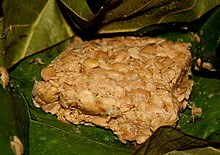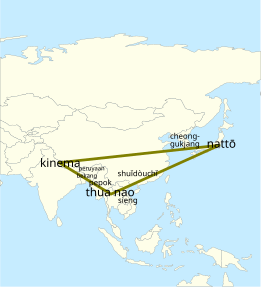Kinema
 Kinema on a traditional leaf wrapping | |
| Alternative names | Chembihik, Hokuma , Goyang, Ghogima, |
|---|---|
| Type | Fermented food |
| Place of origin | Limbuwan (present-day in Sikkim,India and Eastern Nepal) |
| Region or state | Nepal, India (Sikkim, Darjeeling, Kalimpong), Bhutan |
| Created by | Kirati people |
| Main ingredients | Soybean fermented by Bacillus subtilis[1] |
Kinema (Nepali: किनेमा) is a fermented soybean food, prepared by the Kirati communities of the Eastern Himalayas region: Eastern Nepal, and Darjeeling, Kalimpong and Sikkim regions of India.[2] Kinema also known as Kinama, which is a traditional food of the Limbu people.
History[edit]
The word kinema is believed to be derived from the Limbu language kinama, where ki means fermented and nama means to smell.[3] It is a traditional food of the Limbu people .[4]
According to Indian microbiologist Jyoti Prakash Tamang, kinema is estimated to have originated around 600 BC to 100 AD during Kirat dynasty rule, introduced by Limbu people.[5]
Production[edit]
The first step of kinema production is soaking soybeans overnight. The soaked beans are boiled until soft (2–3 hours). Water is drained off and beans are lightly cracked with a mortar. 1% of firewood ash is added and mixed thoroughly. The grits are put in a bamboo bucket lined with local fern (Glaphylopteriolopsis erubescens). The bucket is covered with a jute bag and left to ferment naturally at ambient temperatures for 1–3 days.[2]
No bacterial culture is intentionally added to kinema. Successful fermentation relies on natural bacteria, mainly Bacillus subtilis.[1]
Consumption[edit]
The slimy, odorous product of fermentation is traditionally prepared into a soup that is consumed with rice, but can also be turned into a savoury dip or a pungent side dish to be consumed along with rice or bread. Kinema is traditionally prepared at home, but now it is sold in local markets and even retailed online as a dried product.
Nutritional value[edit]
| Nutritional value per 100 g (3.5 oz) | |
|---|---|
| Energy | 2,000 kJ (480 kcal) |
28g | |
17g | |
48g | |
| †Percentages estimated using US recommendations for adults,[7] except for potassium, which is estimated based on expert recommendation from the National Academies.[8] | |
Kinema is considered a healthy food because fermentation breaks down complex proteins into easily digestible amino acids.[9] The product is alkaline with pH of 7.89, unlike soyabean which has a pH of 6.75. It has 62% moisture content. 48 g of protein, 28 g of carbohydrate, 17 g of fat and 7 g of ash is found in every 100 g of dry kinema. The energy value of Kinema is 2 MJ per 100 grams. Free fatty acidity in kinema is found to be about 33 times higher than raw soybeans.[10]
Similar foods[edit]

Many other Asian countries have Bacillus-fermented soyabean dishes, such as shuǐdòuchǐ of China, cheonggukjang of Korea, nattō of Japan, thua nao of Thailand, tungrymbai of Meghalaya, hawaijaar of Manipur, bekangum of Mizoram, akhuni of Nagaland, and piak of Arunachal Pradesh, India.[11]
Kinema forms one of the vertices of the "natto triangle" proposed by the Japanese ethnobiologist Sasuke Nakao. Jyoti Prakash Tamang proposed a extended ‘KNT (Kinema-Natto-Thua Nao) triangle', connecting the fermented soyabeans across Asia.[2] Nakao hypothesized Yunnan region of China to be the origin place of fermented soyabean technique, as the center of the triangle falls in that region.[12] Jyoti Prakash Tamang shows evidence that fermented soybean styles in India all derive from kinema.[2]
See also[edit]
- Gundruk
- Sinki
- Masaura
- Nattō traditional Japanese food made from fermented soybean
- Cheonggukjang – Traditional Korean food made by fermenting soybeans.
References[edit]
- ^ a b Kharnaior, P; Tamang, JP (2022). "Metagenomic-Metabolomic Mining of Kinema, a Naturally Fermented Soybean Food of the Eastern Himalayas". Frontiers in Microbiology. 13: 868383. doi:10.3389/fmicb.2022.868383. PMC 9106393. PMID 35572705.
- ^ a b c d Tamang, Jyoti Prakash (March 2015). "Naturally fermented ethnic soybean foods of India". Journal of Ethnic Foods. 2 (1): 8–17. doi:10.1016/j.jef.2015.02.003.
- ^ "Kinema—fermented flavours of Kirats and its history". kathmandupost.com. Retrieved 2022-02-14.
- ^ Tamang, Prescilla (2020-07-08). "Axone: The Problematic Representation Of The Nepali Community In The Film". Feminism In India. Retrieved 2022-02-14.
- ^ "Kinema—fermented flavours of Kirats and its history". kathmandupost.com. Retrieved 2022-02-14.
- ^ "KINEMA". TRADITIONAL FERMENTED FOODS AND BEVERAGES OF THE SIKKIM HIMALAYAS.
- ^ United States Food and Drug Administration (2024). "Daily Value on the Nutrition and Supplement Facts Labels". Retrieved 2024-03-28.
- ^ National Academies of Sciences, Engineering, and Medicine; Health and Medicine Division; Food and Nutrition Board; Committee to Review the Dietary Reference Intakes for Sodium and Potassium (2019). Oria, Maria; Harrison, Meghan; Stallings, Virginia A. (eds.). Dietary Reference Intakes for Sodium and Potassium. The National Academies Collection: Reports funded by National Institutes of Health. Washington (DC): National Academies Press (US). ISBN 978-0-309-48834-1. PMID 30844154.
{{cite book}}: CS1 maint: multiple names: authors list (link) - ^ KARKI, ANSUHA (2021-07-05). "Traditional food". The Himalayan Times. Retrieved 2022-02-14.
- ^ Sarkar, P. K.; Tamang, J. P.; Cook, P. E.; Owens, J. D. (1994-02-01). "Kinema — a traditional soybean fermented food: proximate composition and microflora". Food Microbiology. 11 (1): 47–55. doi:10.1006/fmic.1994.1007. ISSN 0740-0020.
- ^ "History of Natto and Its Relatives (1405-2012) - SoyInfo Center". www.soyinfocenter.com. Retrieved 2022-02-14.
- ^ Shurtleff, William; Aoyagi, Akiko (December 2010). History of Soybeans and Soyfoods in South Asia / Indian Subcontinent (1656-2010): Extensively Annotated Bibliography and Sourcebook. Soyinfo Center. ISBN 978-1-928914-31-0.

